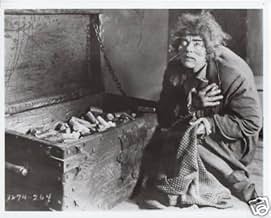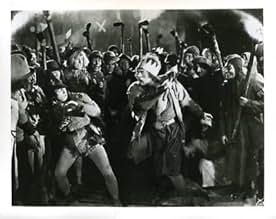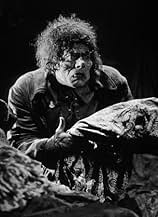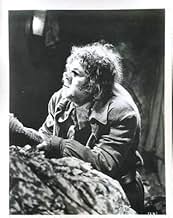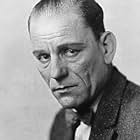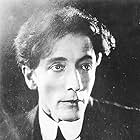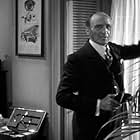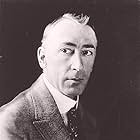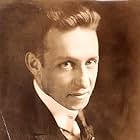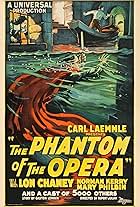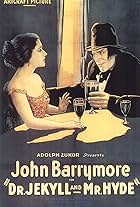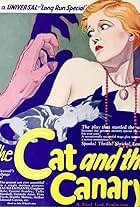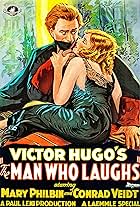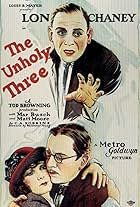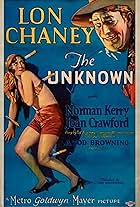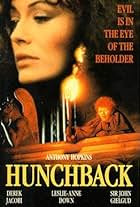IMDb RATING
7.2/10
6.3K
YOUR RATING
In 15th-century Paris, the brother of the archdeacon plots with the gypsy king to foment a peasant revolt. Meanwhile, a freakish hunchback falls in love with a gypsy dancer.In 15th-century Paris, the brother of the archdeacon plots with the gypsy king to foment a peasant revolt. Meanwhile, a freakish hunchback falls in love with a gypsy dancer.In 15th-century Paris, the brother of the archdeacon plots with the gypsy king to foment a peasant revolt. Meanwhile, a freakish hunchback falls in love with a gypsy dancer.
- Awards
- 3 wins & 1 nomination
Nigel De Brulier
- Don Claudio
- (as Nigel de Brulier)
Ernest Torrence
- Clopin
- (as Ernest Torrance)
Harry von Meter
- Mons. Neufchatel
- (as Harry Van Meter)
Nick De Ruiz
- Mons. Le Torteru
- (as Nick de Ruiz)
Ray Myers
- Charmolu's Assistant
- (as W. Ray Meyers)
William Parke
- Josephus
- (as William Parke Sr.)
Storyline
Did you know
- TriviaWallace Worsley Jr., son of the film's director, said that many of the extras for the massive crowd scenes were recruited in downtown Los Angeles for $1.00 a night and meals. Among them, he said, were a good number of prostitutes, who did a "considerable sideline business" on the sets. Universal also hired 50 Pinkerton detectives and put them among the crowd, and their job was to catch pickpockets and various other thieves among the extras.
- GoofsAfter Esmeralda gives Quasimodo water (he's still chained down), the nose putty on Quasimodo's left cheek is coming loose - there's a noticeable gap between Lon Lon Chaney's face and the nose putty used to make the fake cheek.
- Crazy creditsTully Marshall is billed erroneously as "El Rey Luis XI" which is Spanish for "King Louis XI". He should have been billed as "Le Roi Louis XI" which is French for "King Louis XI".
- Alternate versionsSeveral video versions of this film exist, with running times from about 80 minutes up to the full time of the theatrical version.
- ConnectionsEdited into Dream Slashers (2007)
Featured review
THE HUNCHBACK OF NOTRE DAME (Universal, 1923), directed by Wallace Worsley, takes an important step in cinema history. While Victor Hugo's classic novel, published in the 1830s, had been transferred to the screen on several occasions prior to this 1923 adaptation, one of mention titled THE DARLING OF Paris (Fox, 1917) featuring Theda Bara, this production ranks one of the first lavish spectacles Universal had produced thus far, as well as a truly challenging performance for Lon Chaney (1883-1930) in the role of the deformed bell-ringer named Quasimodo. Remade several times thereafter, with the most famous being the 1939 adaptation starring Charles Laughton and Maureen O'Hara for RKO Radio (interestingly not by Universal!), no two versions are exactly alike. In fact, the more recent adaptation transferred to the screen became the 1996 feature length animation musicalized version, but many of the remakes then and now do owe a lot to Chaney's artistic achievement of long ago.
Set in fifteenth century Paris, Quasimodo "deaf, half blind", is a deformed soul attending the gathering of the Festival of Fools. Among the celebrants are Esmeralda (Patsy Ruth Miller), a gypsy girl, "a child of mystery," who enters the city of Notre Dame and dances for the crowd, and Gringoire (Raymond Hatton), a poet-playwright attempting to act out his allegorical play with little success. The crowd encounters the hideous face of Quasimodo, and instantly acclaimed him as the King of the Fools. Normally regarded a monster, Quasimodo has his moment of glory becoming the center of attention before Dom Claude (Nigel De Brullier), the saintly priest, has him return with him to the cathedral. The evil Jehan (Brandon Hurst), has one thing in mind, his lust for the gypsy girl. He sends Quasimodo to abduct her, as witnessed by Phoebus (Norman Kerry), a captain of the guards ("men yielded to his sword, and women to his smile"), rescuing her from the hunchback. After Quasimodo's capture and punishment through flogging, it is Esmeralda, no longer fearing him, to grant him his request for water. Jehan continues his abduction plot on Esmeralda, but because of her love for Phoebus, makes her the accused and sentenced through execution for the stabbing of Phoebus, leading Quasimodo to repay the favor by coming to Esmeralda's aide.
The other members of the cast of thousands include: Ernest Torrence (Clopin, "King of the beggars, enemy of the king" and Esmeralda's "foster father"); Tully Marshall (King Louis XI, "whose dungeons are always full, whose executioners always kept busy"); Kate Lester (Mademoiselle de Gondelaurier); and Gladys Brockwell (Godule, the mysterious reclusive woman who feels gypsies "should all be cursed").
With Chaney's many early screen performances starting in 1914, along with hundreds of characters and thousands of faces, he actually didn't reach true star prominence until after achieving the kind of success long overdue him with THE HUNCHBACK OF NOTRE DAME. In spite of his feature billing, grotesque makeup and sympathetic gestures, Chaney's participation in this production is actually a supporting one. Much has been written about Chaney's makeup, a misshapen face with an eye that droops almost out of its socket, mouth with jagged teeth and twisted legs, wavy hair, but it's his character behind that makeup who really brings out his sympathy and human dignity. Not essentially a horror film, but rather a love story of two misunderstood characters, the hunchback and the gypsy girl. Unlike Victor Hugo's novel, this screen version details very little about Quasimodo's background, yet, spends more time bringing out the true heritage of Esmeralda. This carefully constructed production captures the simplicity of 19th century Paris, from the authentic Notre Dame cathedral down to the costumes, making this one a true classic of the silent screen.
THE HUNCHBACK OF NOTRE DAME and THE PHANTOM OF THE OPERA (1925) remain two of Lon Chaney's most famous screen roles. During the early years of video cassette distributions, these two silent features, which have become public domain titles, were the easiest to obtain. Released through various distributors means alternate versions, ranging from bad video transfers with no musical scoring, to clear picture quality with various types of underscoring, ranging from organ to orchestral, with the majority with the average time frame from 97 to 123 minutes. Blackhawk Video's version contained a Lee Irwin orchestral score with flute sounds, ringing church bells and cathedral chanting. Republic Home Video, along Critic's Choice contained organ scores, color tints and new title cards for its opening introduction. The only debit with Republic's home video transfer is having the final scene as Quasimodo ringings the church bell of Notre Dame for the last time, abruptly ending in freeze frame as the priest (De Brulier) walks towards him, not showing what follows. The print with the abrupt conclusion was the one used in the 1971 presentation of the 13-week series of THE SILENT YEARS as hosted by Orson Welles on public television. At present, many other video and/ or DVD transfers, do feature the original opening title credits and the complete finish focusing on the bell as it slowly stops swinging back and forth before stopping with the THE END (or rather FIN) title card reaches the screen.
THE HUNCHBACK OF NOTRE DAME occasionally appears on cable television's Turner Classic Movies as part of its weekly Silent Sunday Night presentations hosted by Robert Osborne. Due to a renewed interest into the life and career of Lon Chaney, "The Man of a Thousand Faces," this best known version to the Victor Hugo classic should be the one film to consider and study. (***)
Set in fifteenth century Paris, Quasimodo "deaf, half blind", is a deformed soul attending the gathering of the Festival of Fools. Among the celebrants are Esmeralda (Patsy Ruth Miller), a gypsy girl, "a child of mystery," who enters the city of Notre Dame and dances for the crowd, and Gringoire (Raymond Hatton), a poet-playwright attempting to act out his allegorical play with little success. The crowd encounters the hideous face of Quasimodo, and instantly acclaimed him as the King of the Fools. Normally regarded a monster, Quasimodo has his moment of glory becoming the center of attention before Dom Claude (Nigel De Brullier), the saintly priest, has him return with him to the cathedral. The evil Jehan (Brandon Hurst), has one thing in mind, his lust for the gypsy girl. He sends Quasimodo to abduct her, as witnessed by Phoebus (Norman Kerry), a captain of the guards ("men yielded to his sword, and women to his smile"), rescuing her from the hunchback. After Quasimodo's capture and punishment through flogging, it is Esmeralda, no longer fearing him, to grant him his request for water. Jehan continues his abduction plot on Esmeralda, but because of her love for Phoebus, makes her the accused and sentenced through execution for the stabbing of Phoebus, leading Quasimodo to repay the favor by coming to Esmeralda's aide.
The other members of the cast of thousands include: Ernest Torrence (Clopin, "King of the beggars, enemy of the king" and Esmeralda's "foster father"); Tully Marshall (King Louis XI, "whose dungeons are always full, whose executioners always kept busy"); Kate Lester (Mademoiselle de Gondelaurier); and Gladys Brockwell (Godule, the mysterious reclusive woman who feels gypsies "should all be cursed").
With Chaney's many early screen performances starting in 1914, along with hundreds of characters and thousands of faces, he actually didn't reach true star prominence until after achieving the kind of success long overdue him with THE HUNCHBACK OF NOTRE DAME. In spite of his feature billing, grotesque makeup and sympathetic gestures, Chaney's participation in this production is actually a supporting one. Much has been written about Chaney's makeup, a misshapen face with an eye that droops almost out of its socket, mouth with jagged teeth and twisted legs, wavy hair, but it's his character behind that makeup who really brings out his sympathy and human dignity. Not essentially a horror film, but rather a love story of two misunderstood characters, the hunchback and the gypsy girl. Unlike Victor Hugo's novel, this screen version details very little about Quasimodo's background, yet, spends more time bringing out the true heritage of Esmeralda. This carefully constructed production captures the simplicity of 19th century Paris, from the authentic Notre Dame cathedral down to the costumes, making this one a true classic of the silent screen.
THE HUNCHBACK OF NOTRE DAME and THE PHANTOM OF THE OPERA (1925) remain two of Lon Chaney's most famous screen roles. During the early years of video cassette distributions, these two silent features, which have become public domain titles, were the easiest to obtain. Released through various distributors means alternate versions, ranging from bad video transfers with no musical scoring, to clear picture quality with various types of underscoring, ranging from organ to orchestral, with the majority with the average time frame from 97 to 123 minutes. Blackhawk Video's version contained a Lee Irwin orchestral score with flute sounds, ringing church bells and cathedral chanting. Republic Home Video, along Critic's Choice contained organ scores, color tints and new title cards for its opening introduction. The only debit with Republic's home video transfer is having the final scene as Quasimodo ringings the church bell of Notre Dame for the last time, abruptly ending in freeze frame as the priest (De Brulier) walks towards him, not showing what follows. The print with the abrupt conclusion was the one used in the 1971 presentation of the 13-week series of THE SILENT YEARS as hosted by Orson Welles on public television. At present, many other video and/ or DVD transfers, do feature the original opening title credits and the complete finish focusing on the bell as it slowly stops swinging back and forth before stopping with the THE END (or rather FIN) title card reaches the screen.
THE HUNCHBACK OF NOTRE DAME occasionally appears on cable television's Turner Classic Movies as part of its weekly Silent Sunday Night presentations hosted by Robert Osborne. Due to a renewed interest into the life and career of Lon Chaney, "The Man of a Thousand Faces," this best known version to the Victor Hugo classic should be the one film to consider and study. (***)
- How long is The Hunchback of Notre Dame?Powered by Alexa
Details
- Release date
- Country of origin
- Official site
- Language
- Also known as
- Notre Dame'ın Kamburu
- Filming locations
- Production company
- See more company credits at IMDbPro
Box office
- Budget
- $1,250,000 (estimated)
- Runtime2 hours 13 minutes
- Color
- Sound mix
- Aspect ratio
- 1.33 : 1
Contribute to this page
Suggest an edit or add missing content

Top Gap
By what name was The Hunchback of Notre Dame (1923) officially released in India in English?
Answer
